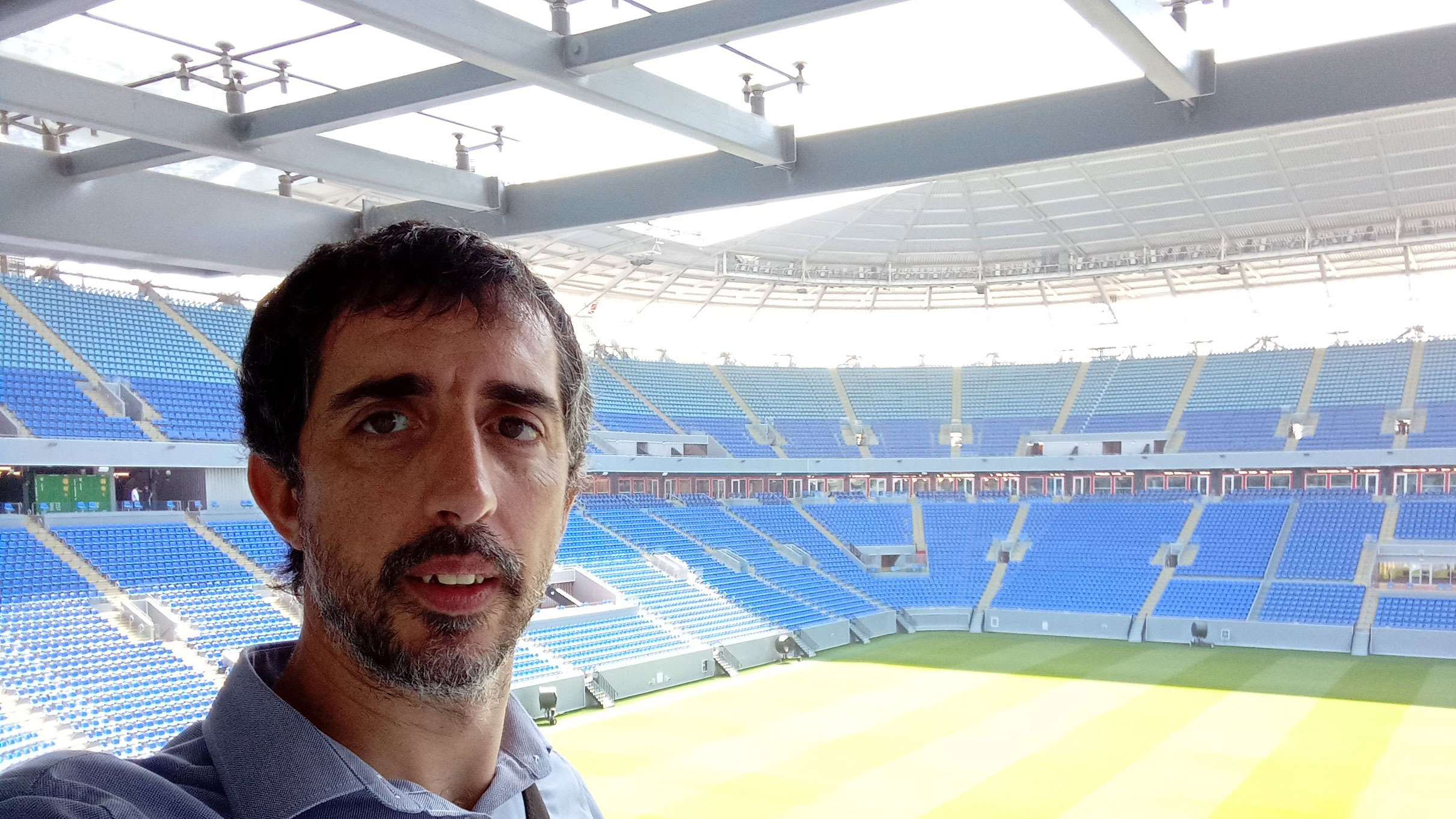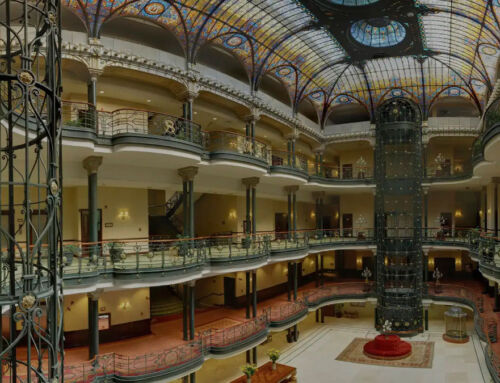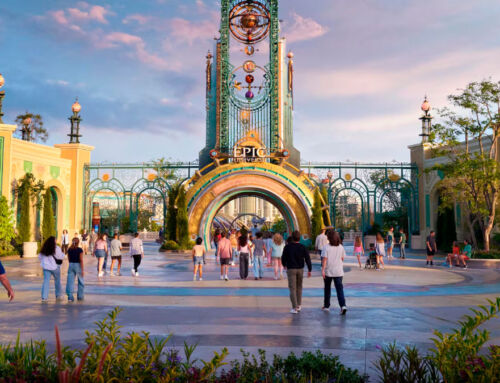We spoke to the third-generation Uruguayan architect, whose career has led him to specialise in sports architecture. He formed part of the team that first developed one of the venues for the FIFA World Cup, Brazil 2014, and then those for the 2022 edition of the big event in Qatar. He is currently preparing the venues for the Milan-Cortina 2026 Olympic and Paralympic Winter Games, as a member of the team of the Fondazione Milano-Cortina, organiser of the international sporting event.
Amusement Logic: You studied architecture at the University of the Republic in Uruguay, what made you decide to become an architect?
Jose Ignacio Masena: Architecture was always present in my life; my grandfather was an architect, as were my father and mother. I remember my first drawings on old plans made on my father and mother’s drawing table. When I started writing I loved to use the lettering stencils that were used in the old days. In that context, it was difficult to escape from the architectural chatter at the table, on walks, on holidays, and so on.
A.L.: What is architecture for you?
J.I.M.: Architecture has different conceptions and definitions. I don’t think there is one particular way of looking at architecture, let alone one way of defining being an architect. As the syllabus of the Faculty of Architecture, Design and Urbanism of Uruguay states, architecture is a constantly evolving way of thinking, which relies on concrete knowledge and its own heuristics in order to provide answers to different situations. In this sense, I am grateful to the training I have received, which has given me the possibility, not only of generating certain products or applying certain techniques, but also of stimulating me to discover new areas of opportunity that broaden the field of architecture’s competence and contribution.
A.L.: How did your career develop until you specialised in architecture for sport?
J.I.M.: I have always been interested in sports architecture. In particular, I am passionate about football stadiums. But I never imagined that I would be able to work with them, and even less so that it would become a family project (my wife Jimena Sellanes, also an architect, works in the same field). I didn’t really plan it, at least not at the beginning. In Uruguay there is no specialisation in sports architecture, so I could say that it almost just happened.
It all began in 2008, when I joined the studio of architect Carlos Arcos. He was working on the renovation proposals for two stadiums in Brazil for the FIFA World Cup Brazil 2014: Arena de Manaus (for 40,000 spectators) and Arena da Baixada, in Curitiba (for another 40,000 spectators). I worked on both proposals as part of the project team and in 2010 we moved to Curitiba, Brazil, to coordinate the renovation and construction process of the World Cup Brazil 2014 host stadium (Arena da Baixada). For 6 years I had the opportunity to participate in almost all the stages of the stadium, from its genesis, through its operation in the biggest football event in the world, to its adaptation, finally, to the legacy desired by Clube Atlético Paranaense. After the experience in Brazil, I joined the construction management team of Antel Arena, an enclosed stadium for 10,000 spectators in Montevideo, Uruguay, as an architect.
In 2017 I joined to work on the construction of several of the host stadiums for the 2022 FIFA World Cup Qatar: Al Thumama Stadium (for 40,000 spectators), 974 Stadium (another 40,000 spectators) and Lusail Stadium (for 90,000 spectators). It was then that we settled in Doha, Qatar, where I again had the opportunity to be involved in almost every stage of the stadium development for 5 years. One of the best experiences of my life was to witness the operation of the 90,000-seater Lusail stadium during the final between Argentina and France. This was undoubtedly one of the greatest satisfactions that this job has given me, which, fortunately, have been many over the last 15 years.
After this madness called Qatar, and for different reasons, we decided it was time to change direction, so we did not hesitate to accept a proposal to join the Fondazione Milano-Cortina, organiser of the Olympic and Paralympic Winter Games Milano-Cortina 2026. We are currently based in Milan, Italy, focusing on the organisation of the Olympic and Paralympic Winter Games.
A.L.: What was your role in the sports stadium projects for the FIFA World Cup Qatar 2022?
J.I.M.: My role during the construction period of the stadiums was to advise and support the Supreme Committee for Delivery and Legacy (the local organising committee for the World Cup) in all aspects of sports architecture. And to ensure that the 3 aforementioned stadiums complied with FIFA standards. These FIFA requirements are constantly being evaluated and updated; they are a product of new technologies, cultural aspects of the host country, new demands from users, sponsors, etc. It is, therefore, a work in progress. Once the construction of the stadiums was completed, I worked on the design of the temporary structures (also called overlay) of the Lusail Stadium.
The Qatar World Cup schedule was a challenge due to the tight schedule. During the tournament, and with my sole focus on the Lusail Stadium, I supported its operation, which required daily evaluations of the proposed solutions and adjustments of everything that could be improved. In the group phase we alternated between MatchDay and Non-MatchDay, which gave very little time for adjustment and response; we had no choice but to be very creative. At the same time, the Lusail stadium hosted the final, so its operation also included the closing and award ceremony. For the latter, the stadium was completely renovated in record time.
A.L.: What special features does an architect working in a country like Qatar encounter?
J.I.M.: I think that what has most distinguished the work in Qatar has been the multicultural atmosphere. While this is common in international events such as the World Cup or the Olympic Games, in the case of Qatar it extends to all areas. Remember that only 10% of Qatar’s population is Qatari; the remaining 90% are expatriates from all over the world. That means an extra challenge, as it involves a constant exercise in adaptation and tolerance.
The size of the teams was another challenge; they were very well sized, which obviously helped to avoid work overload. However, large teams bring with them an extra burden of coordination.
Another particularity is that, in my case, it was my first job in a Muslim country, so I had to adapt to respecting prayer schedules, the month of Ramadan, the week from Sunday to Thursday, etc.
Finally, and perhaps from a South American perspective, I expected Qatar to be less questioning of the way resources were used. To my pleasant surprise, this was not the case, at least in some aspects; the care with planning and the desire to do what was just and necessary, without excesses, was a constant. Of course, we must bear in mind that “excess” does not have the same meaning in South America as it does in the Persian Gulf.
A.L.: What can you tell us about the proposed demountable stadiums that were tested in Qatar and were they dismantled and sent to other countries as planned?
J.I.M.: One of the criticisms that is constantly made of the organisation of world-class sporting events, be it the FIFA World Cup or the Olympic Games, is the so-called “white elephants”, in other words, large infrastructures used for the duration of the big sporting event that then remain inert, empty and unused. In general, they also have a high political cost, as these buildings are hated by the local population who, in addition to having seen millions spent on their construction, must also bear the costs of their upkeep when they are no longer in use.
From the outset, Qatar has sought to minimise the impact of these infrastructures, for which the eight stadiums have been adapted to make them a viable legacy. In some cases, the stadiums will be used as football stadiums for local leagues, so their capacity will be reduced to 50%. Obviously, this is something that is foreseen from the planning stage of the construction, with removable upper stands, etc.
The 974 Stadium is a paradigmatic case. It was conceived as an assembly kit (a mixture of LEGO, MECCANO and IKEA), so that, after the World Cup, it would be totally dismantled to be assembled at a new destination. It is a project by Fenwick Iribarren Architects, a Spanish architectural firm. Their project envisaged that the stadium could be reassembled for 40,000 spectators, or in various smaller and partial ways (only the corners to form a bullring, only the main stand as a grandstand for a swimming pool, other stands for an athletics track, etc.). To this day it is not clear when and how this will be done, but it is clear that it is a very good development. No doubt there are still aspects to be developed, but I think it is a great start.
A.L.: As you were saying, you recently joined the Milano-Cortina 2026 Foundation. What is it and what does your work in it consist of?
J.I.M.: The Milano Cortina 2026 Foundation is the body that will carry out all the organisational, promotional and communication activities for the sporting and cultural events related to the celebration of the XXV Olympic and XIV Paralympic Winter Games in 2026. Since February 2023, I have been the design manager for the competitive and non-competitive venues hosting the Olympic and Paralympic Games. It is another nice challenge, different and far from the world of football, but also linked to sports architecture.
A.L.: How do you see the future of sports architecture in particular, and that of the profession of architecture in general?
J.I.M.: The sports industry in particular, and the entertainment industry in general, is one of the most active, constantly busy industries. Although it suffered a lot during the COVID pandemic, when mass crowds were not allowed and some sporting events had to be postponed (the Tokyo 2020 Summer Olympics, the Dubai 2020 World Expo, etc.), it recovered quickly and today it is almost back to previous levels.
I do believe that mass events have reached a dimension that limits them to certain countries and has an impact on the general spirit of the events. In particular, the men’s World Cups (and to a lesser extent the Summer Olympics) require a huge amount of infrastructure that, even if well planned, exceeds the needs of most host countries. It is necessary to design the facilities as flexibly as possible, always thinking in terms of legacy, and to use these events as a springboard to develop and build what is really needed, adapting them to their realisation.
Currently, Uruguay (together with Argentina, Chile and Paraguay) is thinking about hosting the 2030 FIFA World Cup. This will be a very good opportunity to celebrate the centenary of the first World Cup (and the bicentenary of the country’s independence). The challenge is a beautiful one and will have to be well planned to avoid “white elephants”.






